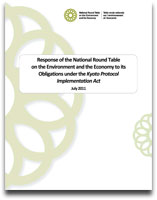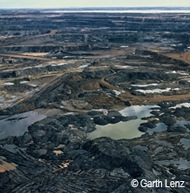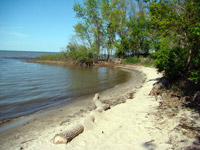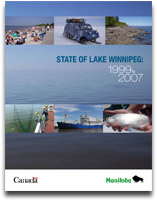
News |
- KI Takes Water Protection Declaration to UN
- Coal Plants Put Climate Commitments at Risk
- Gore Launches Climate Reality Project
- 4 Years Later - Court Orders Woodland Caribou Protection
- Oil Sands Monitoring Plan = Industry Spin, Say Groups
- British Columbia Carbon Neutral?
- Election 2011 Surveys and Reality Checks
- Utilities Board Issues Manitoba Hydro a Warning
- Environment Canada Cuts Risk Environment
- Wastewater Regulations Coming Down the Pipe
- Emergency Lake Manitoba Channel Started
- New Lake Winnipeg Reports Released
| KI Takes Water Protection Declaration to UN | 20 August 11 |
 Kitchenuhmaykoosib Inninuwug (KI) First Nation -- located 440 km north of Sioux Lookout, Ontario, with a population of 1,429 people -- voted overwhelmingly in favour of the The KI Water Declaration and Protocols, during a community referendum July 5, 2011.
Kitchenuhmaykoosib Inninuwug (KI) First Nation -- located 440 km north of Sioux Lookout, Ontario, with a population of 1,429 people -- voted overwhelmingly in favour of the The KI Water Declaration and Protocols, during a community referendum July 5, 2011.The landmark declaration opposes harmful industrial activity on KI's lands; for Big Trout Lake and watersheds to be protected from any industrial use that disrupts, poisons, or harms the lands and waters. The declaration includes a protocol that outlines steps for discussions with government and outside companies over resource management in all of KI territory based on prior informed consent. Chief Donny Morris hopes to take the Declaration to the United Nations when it convenes in September. Chief Morris and five others KI community council members were jailed in 2008 after attempting to stop Platinex from engaging in mining exploration in KI territory. After public outcry, an appeals court released the KI leaders. In 2009 the province of Ontario bought out the mining claims in the KI traditional area, and promised never to develop them without KI's support. The idea for the declaration first sparked as Chief Morris sat in his prison cell in 2008 to 2009. He and the other prisoners, the KI Six, as they came to be known, contemplated how they could protect their lands from disruptive development and exploration in the future. "It made us see what we needed to do to get from A to B. We need to start mobilizing," said Morris. Earthroots, Greenpeace and Council of Canadians are among a organizations that have signed a letter supporting the declaration. View Kitchenuhmaykoosib Inninuwug (KI) First Nations websiteWatch Youtube video of KI Chief Donny Morris View August 3, 2011 Rabble.ca article View July 13, 2011 Greenpeace blog post View July 7, 2011 Council of Canadians release View May 13, 2008 Manitoba Wildlands news item Sources:
Rabble.ca, Greenpeace
|
|
 Print version Print version |
Top |
| Coal Plants Put Climate Commitments at Risk | 20 August 11 |
 Having walked away from the Kyoto Protocol, Canada's government will not achieve its Copenhagen commitment either, unless more serious action begins, according to new reports by Environment Canada and the National Roundtable on the Environment and Economy (NTREE).
Having walked away from the Kyoto Protocol, Canada's government will not achieve its Copenhagen commitment either, unless more serious action begins, according to new reports by Environment Canada and the National Roundtable on the Environment and Economy (NTREE).According to a July 2011 Environment Canada report, entitled Canada's Emission Trends current Government actions are only expected to reduce greenhouse-gas (GHG) emissions by about one-quarter of the reductions needed to meet the 2020 Copenhagen target. Another July 2011 report, from the National Roundtable on the Environment and Economy (NTREE), entitled Response of the National Round Table on the Environment and the Economy to its Obligations under the Kyoto Protocol Implementation Act, analyzes obligations to reduce Canada's carbon pollution, under the 2007 Kyoto Protocol Implementation Act. The report finds Canada's emissions reduction policies are about half as effective as projected. Still the Canadian Government continues to allow new coal-fired electricity, such as the Maxim Power plant in Alberta, while subsidizing the fossil fuel industry, and delaying meaningful action to reduce emissions. More than 40 civil society organizations across Canada signed a letter calling on Environment Minister Peter Kent to avoid any coal plant being exempt from upcoming regulations, and to avoid licensing new conventional coal plants in Canada. "Stephen Harper can't allow new coal-fired electricity plants to be built, ...and achieve his promise to reduce Canadian greenhouse-gas emissions 17 per cent by 2020. As a researcher of energy-economy systems, I say this with virtual certainty," said Mark Jaccard of Simon Fraser University. View July 2011, Environment Canada, Canada's Emission Trends reportView July 2011, National Roundtable on the Environment and Economy report View August 11, 2011 Climate Action Network release View August 9, 2011 Pembina Institute blog post View August 4, 2011 Canadian Centre for Policy Alternatives View August 3, 2011 Desmogblog post View July 30, 2011 Montreal Gazette article View Manitoba Wildlands Climate Change Canada Initiatives page Sources:
Globe and Mail, Canadian Centre for Policy Alternatives, NRTEE, CAN-RAC
|
|
 Print version Print version |
Top |
| Gore Launches Climate Reality Project | 20 August 11 |
 "The climate crisis is a reality, and we are seeing its impacts in extreme weather all around the world. Using the same deceitful playbook as big tobacco used years before to mislead the public about the dangers of smoking, oil and coal companies and their allies are now deceiving the public about climate change. They have nearly unlimited resources to sow doubt, but we have one critical advantage: Reality is on our side," said Gore.
"The climate crisis is a reality, and we are seeing its impacts in extreme weather all around the world. Using the same deceitful playbook as big tobacco used years before to mislead the public about the dangers of smoking, oil and coal companies and their allies are now deceiving the public about climate change. They have nearly unlimited resources to sow doubt, but we have one critical advantage: Reality is on our side," said Gore.The 24 hour Climate Reality event will focus the world on the climate crisis via live online broadcast September 14-15. 24 Presenters in 24 time zones in 13 languages will be providing a multimedia presentation, created by Al Gore, which will connect the dots between recent extreme weather events – including floods, droughts and storms. 350.org is preparing for September 24 events around the world by launching Moving Planet. Their aim is to have events – a worldwide rally – in support of The Reality Project's message for urgent action on climate change. The partnership between Moving Planet and the Reality Project will multiply participation. "The climate crisis knows no political boundaries. Ferocious storms and deadly heat waves are occurring with alarming frequency all over the world. We are living with the reality of the climate crisis every day. The only question is, how soon can we act?" stated Al Gore. Watch Climate Reality video trailerWatch 350.org Moving Planet campaign for September 24, 2011 View Climate Reality Project website View August 9, 2011 Los Angeles Times blog post View August 9, 2011 New York Times article View August 9, 2011 ABC blog post View July 13, 2011 Green Living Ideas article View July 12th, 2011 Huffington Post article View August 19, 2011 Common Dreams article Sources:
|
|
 Print version Print version |
Top |
| 4 Years Later - Court Orders Woodland Caribou Protection | 13 August 11 |
 A July 28, 2011 Federal Court decision is forcing Canadian Environment Minister Peter Kent to revisit his March 2011 decision to refuse emergency protections for woodland caribou in Alberta affected by oil sands development. The court found Kent's decision contradictory with the very same report relied upon to recommend against emergency protections.
A July 28, 2011 Federal Court decision is forcing Canadian Environment Minister Peter Kent to revisit his March 2011 decision to refuse emergency protections for woodland caribou in Alberta affected by oil sands development. The court found Kent's decision contradictory with the very same report relied upon to recommend against emergency protections.The lawsuit is an important victory for First Nations applicants. "This is yet another significant court decision which upholds the treaty rights of First Nations in Canada, and by protecting the caribou herds and caribou habitat, these and other First Nation communities can and will continue to exercise their traditional rights and practices, including hunting, trapping and fishing," said Canadian Assembly of First Nations National Chief Shawn Atleo. "Given the evidence, and the court's decision, the only reasonable conclusion Minister Kent can come to is that he must recommend emergency protection for the caribou," said Ecojustice staff lawyer Melissa Gorrie. The Canadian Government now has until September 1, 2011 to implement a draft recovery strategy for woodland caribou (which is already four years late) under the provisions of the Species At Risk Act (SARA), based on the court decision. View Federal Court of Canada decisionView August 4, 2011 Indigenous Peoples Issues & Resources article View August 9, 2011 Victoria Times Colonist article View August 3, 2011 Ft. McMurray Today article View July 29th, Eco-justice/Pembina Institute press release View July 29, Pembina Institute Blog post View Manitoba Wildlands Caribou Strategies page Sources:
Pembina Insitute/Eco-justice
|
|
 Print version Print version |
Top |
| Oil Sands Monitoring Plan = Industry Spin, Say Groups | 13 August 11 |
 Canadian Environment Minister Peter Kent updated March 2011 Phase 1- Integrated Monitoring Plan for the Alberta Oil Sands: Water, with Phase 2 - Integrated Monitoring Plan for the Alberta Oil Sands: Water on July 21, 2011.
Canadian Environment Minister Peter Kent updated March 2011 Phase 1- Integrated Monitoring Plan for the Alberta Oil Sands: Water, with Phase 2 - Integrated Monitoring Plan for the Alberta Oil Sands: Water on July 21, 2011.The plan comes after an Alberta-appointed expert panel concluded, in a July 5, 2011 report, that current monitoring of Alberta oilsands projects and extraction is insufficient and needs to have "rigorous scientific design and execution" to be effective. Kent said the new federal monitoring plan will "provide the facts and the science to defend the [oilsands] product, which some abroad are threatening to boycott." Environmental experts say the Canadian government needs to come up with a system of enforceable regulations, and worry the monitoring plan is more about public relations than environmental protection. Newly released e-mails and internal records show the Canadian Association of Petroleum Producers, an industry lobby group, was responsible for organizing a March 2010 secret strategy meeting involving senior Canadian and Albertan government officials, as well CEOs from oil and gas companies, to develop an advocacy campaign to polish the image of Alberta's oilsands industry. "The federal government clearly isn't protecting the Alberta environment, or seriously addressing climate change. Their primary concern is protecting big oil profits and stemming bad PR," said John Bennett of Sierra Club Canada. "More data alone will not stop the growing pollution problem. Ottawa already has the legal authority to act," said Environmental Defence program manager Gillian McEachern. "It's just so frustrating because it's so clear that what we're seeing is an international energy policy (in Canada) based on promoting the short-term interests of the oil companies, rather than: long-term interests of Canadians; the fight against climate change and, promotion of clean energy," said Graham Saul executive director of Climate Action Network. View March 22, 2011 Environment Canada, Phase 1- Integrated Monitoring Plan for the Alberta Oil Sands: Water (PDF)View July 21, 201 Environment Canada, Phase 2 - An Integrated Monitoring Plan for the Alberta Oil Sands: Water (PDF) View July 5, 2011 Government of Alberta Environmental Monitoring Panel Report View August 9, 2011 Postmedia News article View August 8, 2011 Hill Times article View July 26, 2011 Edmonton Journal article View July 21, 2011 Sierra Club of Canada release Sources:
CBC, Postmedia, Sierra Club of Canada, Climate Action Network Canada
|
|
 Print version Print version |
Top |
| British Columbia Carbon Neutral? | 13 August 11 |
 The British Columbia (B.C.) government says the public sector in the province has become carbon neutral, the first jurisdiction in North America to do so.
The British Columbia (B.C.) government says the public sector in the province has become carbon neutral, the first jurisdiction in North America to do so.The B.C. government says it's achieved this with energy conservation projects in schools, hospitals and other provincial buildings, and by purchasing carbon offsets, in clean energy projects. The government admits the public sector accounts of just one per cent of all greenhouse gas emissions in B.C., and school and transit buses are exempt from the carbon neutral goal, but it says the sector can inspire others to reduce their carbon footprint. Critics, including independent B.C. MLA Bob Simpson and B.C. NDP Environment critic Rob Fleming, say the government's carbon neutral claim has achieved very little in terms of actual greenhouse gas emissions reductions. Pacific Carbon Trust, the B.C. publicly owned carbon credit agency, which provincial institutions are required to buy from, is making profits from carbon offsets. "A myth like carbon neutral would be relatively harmless if it were just something that businesses and individuals did on their own. But when adopted as official government policy, it can be harmful," stated Mark Jaccard professor of sustainable energy at Simon Fraser University. View July 22, 2011 The Tyee articleView July 20, 2011 Vancouver Sun article View July 13, 2011 Progress Economics Forum article View June 30, 2011 Canadian Press article View June 30, 2011 B.C. Government release View Pacific Carbon Trust website Sources:
Canadian Press, Tyee
|
|
 Print version Print version |
Top |
| Election 2011 Surveys and Reality Checks | 6 August 11 |
 Manitoba's 2011 provincial election is less than 60 days away, and Manitoba Wildlands has already sent the first batch of election surveys to the four major political parties in Manitoba. Election survey answers for each election survey since 1999 are posted on the Manitoba Wildlands website.
Manitoba's 2011 provincial election is less than 60 days away, and Manitoba Wildlands has already sent the first batch of election surveys to the four major political parties in Manitoba. Election survey answers for each election survey since 1999 are posted on the Manitoba Wildlands website.Each focuses on a particular environmental topic. The first surveys focus on Lake Winnipeg, environmental licensing, Manitoba Hydro and energy policy, and the East Side of Lake Winnipeg. Responses are required from the political parties two weeks from receiving the surveys. "Voters need to know where our political parties stand on the environment. Transparent information is vital to democracy," said Manitoba Wildlands director Gaile Whelan Enns. New this election, Manitoba Wildlands is posting a series of "Reality Checks." Reality Checks ask and answer a particular question pertaining to environmental issues, and provide further references. More than twenty Reality Checks has been posted since February 2011. Manitoba Wildlands will continue posting further election surveys and Reality Checks in preparation for the October 4, 2011 election. Manitoba Wildlands is a non-profit environmental and public research organization. We work with communities, industry sectors, and environmental organizations for the future of Manitoba's lands and waters. View Manitoba Wildlands 2011 Manitoba Election Surveys View Manitoba Wildlands Reality Checks 2011 |
|
 Print version Print version |
Top |
| Utilities Board Issues Manitoba Hydro a Warning | 6 August 11 |
 Manitoba's Public Utilities Board is rejecting a Manitoba Hydro proposal for higher hydro rates but is warning that hydro costs could skyrocket.
Manitoba's Public Utilities Board is rejecting a Manitoba Hydro proposal for higher hydro rates but is warning that hydro costs could skyrocket.The regulatory agency has turned down a request from Manitoba Hydro for a 0.9 per cent rate increase on August 1. The agency has also issued a warning to the Crown-owned utility that it may be seriously underestimating the risks from developing new hydro capacity. Manitoba Hydro is planning to build three new generating stations with transmission lines, and a new transmission line to both supply Manitoba customers, and to fuel exports to the United States. The PUB, however, says projected construction costs have soared by and export prices are dropping. The board says Manitoba customers could end up subsidizing export sales and it's asking Manitoba Hydro to consider alternative construction plans. During hearings earlier this year on other matters, Manitoba Hydro refused a Board subpoena to provide its export contracts. The matter is now before the Manitoba Court of Appeal. The utilities Board said Hydro also failed to provide an updated financial forecast. "The corporation either refused or failed to provide the Board information that the Board considers critical to it reaching a comprehensive and final perspective on the prudency of (Manitoba Hydro's) actions and plans," the Board wrote. View July 29, 2011 Manitoba Public Utilities Board order 99/11 (PDF)View July 29, 2011 Winnipeg Free Press article View July 29, 2011 CBC News article View July 29, 2011 Winnipeg Sun article Sources:
Canadian Press
|
|
 Print version Print version |
Top |
| Environment Canada Cuts Risk Environment | 6 August 11 |
 Meteorologists, scientists, chemists and engineers are among more than 700 Environment Canada employees on the chopping block as the department launches sweeping cuts.
Meteorologists, scientists, chemists and engineers are among more than 700 Environment Canada employees on the chopping block as the department launches sweeping cuts.The cuts represent 11 per cent of the workforce at Environment Canada, calling into question the department's ability to carry on its mandate, said Bill Pynn, national president of the Union of Environment Workers, which represents 476 of the affected workers. Nearly 50 Canadian civil society organizations and experts sent a statement to Prime Minister Stephen Harper decrying the cuts to Environment Canada and outlining serious concerns about the impacts from loosing these staff, July 4, 2011. The statement was endorsed by Council of Canadians, Canadian Union of Public Employees, Centre for Indigenous Environmental Resources, International Institute of Concern for Public Health, Keepers of the Athabasca Watershed Council, Métis Women's Circle, Mining Watch Canada, National Council of Women of Canada, National Network on Environments and Women's Health, Polaris Institute, Public Service Alliance of Canada, and Sierra Club Canada, among others. "At the very least, the Harper government owes the public clear explanations of how the core activity of Environment Canada will not be harmed by these layoffs. What is the timeline and what areas of the department will be affected? How will we ensure that critical roles are not left vacant? There are too many questions and no good answers regarding this slashing of a critical government department," said Green Party of Canada Leader Elizabeth May. View July 4, 2011 Council of Canadians releaseView July 4, 2011 letter to Prime Minister Harper (PDF) View August 3, 2011 Toronto Star article View August 3, 2011 Green Party of Canada release View July 28, 2011 Green Conduct article Sources:
Toronto Star, Green Party of Canada
|
|
 Print version Print version |
Top |
| Wastewater Regulations Coming Down the Pipe | 6 August 11 |
 A proposed regulation under the Water Protection Act, which updates standards for nutrient reduction in municipal and industrial waste water across Manitoba, is likely to come into force shortly.
A proposed regulation under the Water Protection Act, which updates standards for nutrient reduction in municipal and industrial waste water across Manitoba, is likely to come into force shortly.Manitoba Water Quality Standards, Objectives and Guidelines, first drafted in 2002, were updated July 4, 2011, and are set to be incorporated into the regulation. No response to public comments received in 2002 was ever provided. Nothing has been added to the public registry. The public review process for the regulation was announced in a single paragraph of a July 4th press release, which dealt with numerous other announcement as well. Essentially the announcement of the review was lost in the press release. No other form of notification was undertaken by Manitoba Water Stewardship. Comments were due by August, 4 2011. "In the middle of summer, with many people battling flood waters, clearly more could have been done to engage the public. Or the government could have avoided a summer review all together. At minimum the request for public comments deserved it's own press release or notification to stakeholders," stated Manitoba Wildlands director Gaile Whelan Enns. Manitoba Wildlands found the links on the Water Stewardship department web pages for the regulation, and the 2002 Water Quality Standards do not work. This hampers any ability to provide comments, and means that review itself will need to be extended. View proposed Manitoba Water Quality Standards, Objectives and Guidelines Regulation (PDF)View July 4, 2011 Manitoba Water Quality Standards, Objectives and Guidelines (PDF) View July 4, 2011 Government of Manitoba release View Manitoba Water Stewardship website Sources:
Government of Manitoba
|
|
 Print version Print version |
Top |
| Emergency Lake Manitoba Channel Started | 27 July 11 |
 Preliminary work has begun on a $100-million emergency channel to drain water from Lake St. Martin through the new channel to the Dauphin River and into Lake Winnipeg. It is hoped, but not guaranteed, that work will be completed by November 2011 to prevent further Lake Manitoba flooding in 2012.
Preliminary work has begun on a $100-million emergency channel to drain water from Lake St. Martin through the new channel to the Dauphin River and into Lake Winnipeg. It is hoped, but not guaranteed, that work will be completed by November 2011 to prevent further Lake Manitoba flooding in 2012.Manitoba wants the Canadian Government to cover 90 per cent of the costs under federal disaster assistance, but no assurances have been given. The five-mile (8 kilometre) long, 300 ft. (90 meters) wide, 25 ft. (7.5 meters) deep channel is expected to involve excavation of as much as 88 million cubic ft. (2.5 million cubic metres) of earth, 50 pieces of heavy equipment, and 150 staff. Barges, helicopters, and helicopter landing pads to get equipment and staff into areas inaccessible by road are required. The engineering report commissioned by the province makes little mention of potential environmental impacts, such as: the transfer between water-bodies, introduction of foreign species, and sedimentation. Manitoba Wildlands was unable to find any public information about permitting and licensing for the channel. University of Manitoba engineering professor Jay Doering has questioned the viability of such a channel. "It's very naive of us to believe that we can control the level of Lake Manitoba to the extent that we want to. My concern is the government is simply looking for a quick fix to a politically contentious issue," said Doering. View July 2011 KGS Group & AECOM report (PDF)View July 26, 2011 Manitoba Government press release View July 27, 2011 Winnipeg Free Press article View July 26, 2011 CBC News article View July 26, 2011 Toronto Star article View July 5, 2011 Winnipeg Sun article View Government of Manitoba, Flood Information page View Manitoba Wildlands Water Projects page Sources:
Government of Manitoba, Toronto Star, Winnipeg Sun
|
|
 Print version Print version |
Top |
| New Lake Winnipeg Reports Released | 27 July 11 |
 State of Lake Winnipeg report, released by Manitoba Water Stewardship and Environment Canada, July 4, 2011, is a comprehensive assessment of the physical, chemical, and biological characteristics of Lake Winnipeg based upon lake monitoring from 1999 to 2007.
State of Lake Winnipeg report, released by Manitoba Water Stewardship and Environment Canada, July 4, 2011, is a comprehensive assessment of the physical, chemical, and biological characteristics of Lake Winnipeg based upon lake monitoring from 1999 to 2007.It is a collaborative effort government, universities, and non-governmental researchers meant to serve as a reference to measure progress towards reducing nutrient loading, and assess the overall health of Lake Winnipeg. The 'Leavitt report', prepared by Dr. Peter Leavitt, Canada Research Chair in Environmental Change and Society (University of Regina), released May 31, 2011, is based on the monitoring and lake bottom sediment samples. The Leavitt report examines the historical water quality conditions of Lake Winnipeg's south basin prior to the early 1800s, and how the lake has changed up to the present time. The study concluded that 50 per cent of the build-up in phosphorus levels was due to livestock and crop production in Manitoba. "Dr. Leavitt's research spells it out clearly: Lake Winnipeg is at risk," said Manitoba Premier Greg Selinger. In June 2011 the Manitoba Government enacted the Save Lake Winnipeg Act. Manitoba has committed to reducing the phosphorous load on Lake Winnipeg by 50%. No timeline is provided as to when this will be achieved. View May 31, 2011 Lake Winnipeg report (PDF)View July 4, 2011 Manitoba Water Stewardship, State of Lake Winnipeg Report page View July 4, 2011 Manitoba Government News Release View May 31, 2011 Manitoba Government News Release View Manitoba Water Stewardship, Lake Winnipeg page View Manitoba Wildlands, Lake Winnipeg Research page View Manitoba Wildlands Lake Winnipeg page Sources:
Government of Manitoba
|
|
 Print version Print version |
Top |


 RSS Feeds:
RSS Feeds: